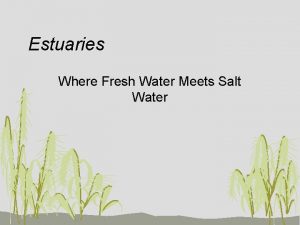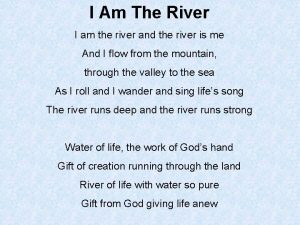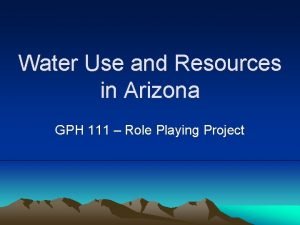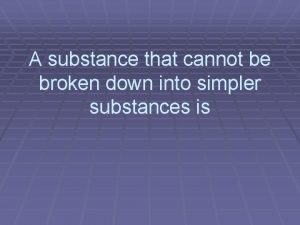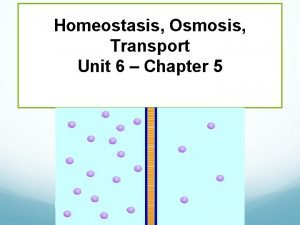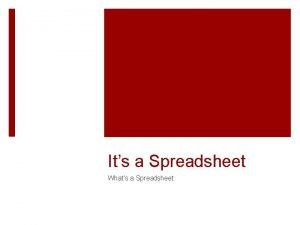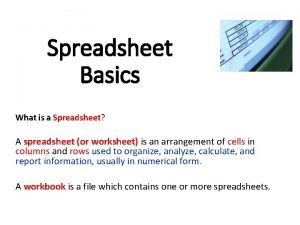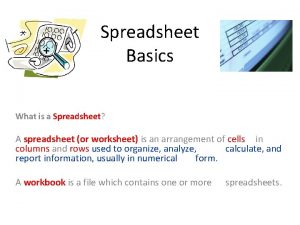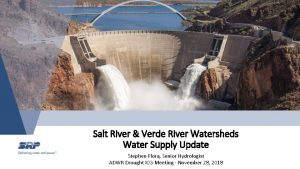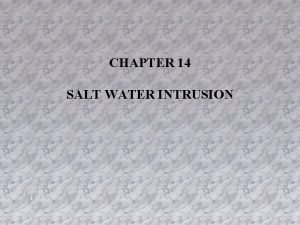River Salt A spreadsheet program Water and salt









- Slides: 9

River. Salt A spreadsheet program Water and salt balances along rivers in (semi)arid zones that provide water for irrigation and receive drainage return flow

River salinity increases to harmful levels downstream • In irrigation projects along the river the salt concentration of the water increases due to evaporation • The flow of drainage water returned to the river is also more saline and spoils the quality of the river water • Further downstream the soils may become too saline and agriculture suffers.

Downstream river salinity in Egypt and Pakistan • Egypt has a long and big river: the Nile. Its waters are used for extensive irrigation. Downstream, in the North of the Nile Delta, the irrigation water is salty and agricultural lands are barren due to soil salinity. • Pakistan also has a long and big river: the Indus. Downstream, in Sindh province, the irrigation water is salty and many lands are barren due to soil salinity • In Egypt the available amount of irrigation water per ha is more than in Pakistan. • Therefore in Pakistan the problem is more serious than in Egypt

Example of salt import in irrigation project • • Good quality water 0. 5 g salt / l water EC = 0. 75 d. S/m Irrigation 10 000 m 3 per ha per year Salt import is 5000 kg per ha per year • When salinity is 1 g/l and irrigation is 20000 m 3 (sugar cane) then import is 20 T

Example of soil and return flow salinity • If irrigation efficiency is 90% (very high), then 10% of the irrigation water is drained an returned to the river. • If salinity irrigation water is 1 d. S/m (reasonable quality) and leaching efficiency is 100%, then soil salinity is 10 d. S/m (saline soil) and salinity of return flow is also 10 d. S/m • If leaching efficiency is 50%, then soil salinity is 20 d. S/m (very saline).

Schematic diagram of river with irrigation projects, return flow, and salinity

Application to reality • The previous diagram has been used in the spreadsheet program Salty. River. This will be shown later. • Adaptations of the spreadsheet to local situations can be made without much difficulty • This gives a tool for: – monitoring river and soil salinity – simulate the effects of different measures for salinity control – predict the effects of new developments • For more accuracy one can use the agro-hydro-salinity model Salt. Mod in each irrigation project separately to determine soil and drainage salinity more precisely

Soil salinity control • In Egypt and Pakistan outfall drains are used to take the salty river water to the sea instead of returning it to the river • In Australia and USA evaporation ponds (artificial lakes) are used so that drainage water is evaporated instead of returning it to the sea • In India land is sacrificed (also called retired): part of the agricultural land is taken out of use or put under salt tolerant trees and allowed to become saline. Evaporation occurs by capillary rise. • For Garmsar I proposed a combined system of drainage and strip cropping

Conclusions • The optimal management of river water, irrigation, drainage for salinity control consists of a combination of measures adjusted to local conditions • The interactions are complex • It is useful to apply simulation models as a tool to assist the managers to reach the optimal decisions. • Now we will demonstrate the Salty. River program
 Water and water and water water
Water and water and water water Fresh water meets salt water
Fresh water meets salt water Microsoft excel merupakan program aplikasi ...
Microsoft excel merupakan program aplikasi ... I am the river and the river is me
I am the river and the river is me Salt river project
Salt river project Salt river higher education
Salt river higher education Green river (duwamish river tributary)
Green river (duwamish river tributary) Apparatus used in evaporation
Apparatus used in evaporation It is a substance that cannot be broken down
It is a substance that cannot be broken down Osmosis water and salt
Osmosis water and salt

